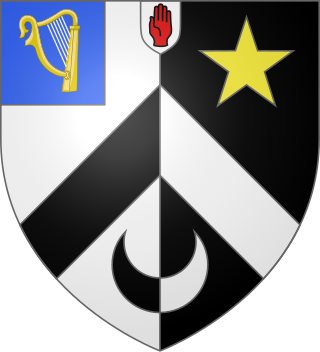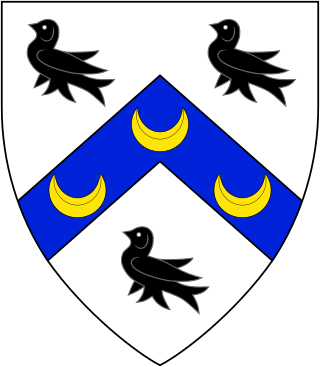Baron Ventry, of Ventry in the County of Kerry, is a title in the Peerage of Ireland. It was created in 1800 for Sir Thomas Mullins, 1st Baronet. He had already been created a Baronet, of Burnham in the County of Kerry, in the Baronetage of Ireland in 1797. The Mullins family claimed descent from the Norman De Moleyns family. The first Baron's grandson, the third Baron, resumed the alleged 'ancient' family name of De Moleyns by Royal licence in 1841. His son, the fourth Baron, sat in the House of Lords as an Irish Representative Peer from 1871 to 1914. Lord Ventry also assumed the additional surname of Eveleigh, which was that of an earlier ancestor. His younger son, the sixth Baron, married Evelyn Muriel Stuart Daubeny. As of 2014 the titles are held by their grandson, the eighth Baron, who succeeded his uncle in 1987. In 1966 he assumed by deed poll the surname of Daubeney de Moleyns.
There have been two baronetcies created for persons with the surname Waller, one in the Baronetage of Ireland and one in the Baronetage of the United Kingdom. One creation is extant as of 2019.

The Alexander, later Cable-Alexander Baronetcy, of the City of Dublin, is a title in the Baronetage of the United Kingdom. It was created on 11 December 1809 for William Alexander, Lord Mayor of Dublin. The second Baronet was a Director of the Bank of Ireland. The third Baronet was Attorney-General to Albert Edward, Prince of Wales, later Edward VII. The seventh Baronet assumed in 1931 by deed poll the additional surname of Cable. As of 31 December 2013 the present Baronet has not successfully proven his succession and is therefore not on the Official Roll of the Baronetage, with the baronetcy considered dormant.
The Dudley-Williams Baronetcy, of the city and of the county of the city of Exeter, is a title in the Baronetage of the United Kingdom. It was created on 2 July 1964 for the aeronautical engineer and Conservative politician, Sir Rolf Dudley-Williams. On receiving the baronetcy, on 29 June 1964 Williams changed his surname to Dudley-Williams by deed poll. As of 2010 the title is held by his son, the second Baronet, who succeeded in 1987.

William Morgan Fletcher-Vane, 1st Baron Inglewood, TD, was a British Conservative Party politician.

There have been four baronetcies created for persons with the surname Sykes, two in the Baronetage of Great Britain and two in the Baronetage of the United Kingdom. Three of the creations are extant as of 2008.

There have been twenty one baronetcies created for persons with the surname Williams, eight in the Baronetage of England, three in the Baronetage of Great Britain and ten in the Baronetage of the United Kingdom. Only six of the creations are extant as of 2017.

There have been nine baronetcies created for persons with the surname Cooper, one in the Baronetage of England, one in the Baronetage of Ireland and seven in the Baronetage of the United Kingdom.
The Cotts Baronetcy, of Coldharbour Wood in the parish of Rogate in the County of Sussex, is a title in the Baronetage of the United Kingdom. It was created on 15 June 1921 for Sir William Cotts, KBE. He was head of Mitchell Cotts and Co, of London, and of allied companies, merchants, colliery proprietors and steamship owners, and also briefly represented Western Isles in the House of Commons as a National Liberal. The second Baronet assumed by deed poll the additional surname of Mitchell in 1932. He was an actor, writer, journalist, and publisher.
There have been five baronetcies created for persons with the surname Evans, one in the Baronetage of Ireland and four in the Baronetage of the United Kingdom. All of the baronetcies are now extinct.
There have been three baronetcies created for persons with the surname Denny, one in the Baronetage of England, one in the Baronetage of Ireland and one in the Baronetage of the United Kingdom. As of 2014 two of the creations are extant.
There have been five baronetcies created for persons with the surname Green, one in the Baronetage of England, one in the Baronetage of Great Britain and three in the Baronetage of the United Kingdom. Only one creation is extant as of 2007.

There have been seven baronetcies created for persons with the surname Watson, one in the Baronetage of England, one in the Baronetage of Great Britain and five in the Baronetage of the United Kingdom. One creation is extant as of 2016.
There have been three baronetcies created for persons with the surname Pole, one in the Baronetage of England, one in the Baronetage of Great Britain and one in the Baronetage of the United Kingdom. Two of the creations are extant as of 2008.
There have been three baronetcies created for persons with the surname Clayton, two in the Baronetage of Great Britain and one in the Baronetage of the United Kingdom. One creation is extant as of 2021.
The Baker, later Sherston-Baker Baronetcy, of Dunstable House in Richmond in the County of Surrey, is a title in the Baronetage of Great Britain. It was created on 14 May 1796 for Robert Baker, in honour of him raising and maintaining a cavalry regiment of 500 men styled "The Richmond Rangers" for King George III. He was succeeded by his son, the second Baronet. He was a vice-admiral in the Royal Navy. The fourth Baronet was a Recorder of Helston and of Barnstaple and Bideford and a County Court judge. The fifth Baronet assumed by deed poll the additional surname of Sherston in 1923. The Baker family was settled in the Westcountry several centuries before the creation of the baronetcy. A version of the arms used by the Baker baronets is displayed on the mural monument in Dunchideock Church in Devon of Aaron Baker (1620–1683) of Bowhay in the parish of Exminster, Devon, first President of the Madras Presidency.
There have been two baronetcies created for persons with the surname Ramsden, one in the Baronetage of England and one in the Baronetage of the United Kingdom. One creation is extant as of 2008
The Robinson, later Lynch-Robinson Baronetcy, of Lisnacarrig, Foxrock in the County of Dublin, is a title in the Baronetage of the United Kingdom. It was created on 30 January 1920 for Sir Henry Robinson, KCB, vice-president of the Local Government Board for Ireland from 1898 to 1920. The second Baronet assumed in 1947 by deed poll the additional surname of Lynch.
This is a list of High Sheriffs of Carmarthenshire. Carmarthenshire was originally created by the Statute of Rhuddlan in 1284. It became an administrative county in 1889 with a county council following the Local Government Act 1888. Under the Local Government Act 1972, the administrative county of Carmarthenshire was abolished on 1 April 1974 and the area of Carmarthenshire became three districts within the new county of Dyfed : Carmarthen, Dinefwr and Llanelli. Under the Local Government (Wales) Act 1994, Dyfed was abolished on 1 April 1996 and the three districts united to form a unitary authority which had the same boundaries as the original Carmarthenshire but remaining in the shrievalty of Dyfed.

The Jones, later Prichard-Jones Baronetcy, of Bron Menai, Dwyran, in Llangeinwen in the County of Anglesey, is a title in the Baronetage of the United Kingdom. It was created on 15 July 1910 for John Jones, head of Dickins and Jones (Limited) and founder of the Prichard-Jones Institute and Cottage Homes, Newborough, Anglesey. In 1917 he assumed by deed poll the additional surname of Prichard.






